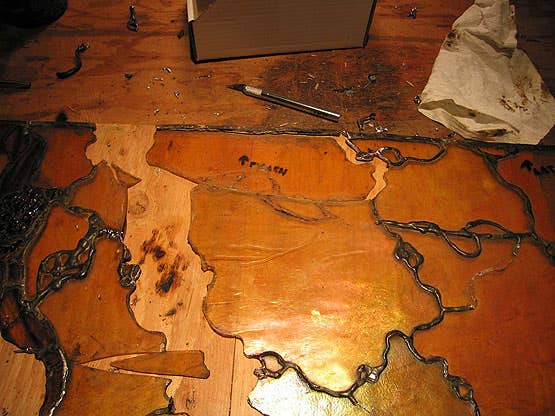Old Leaded Glass: Repair, restore or replace?
Your old art glass may be precious heirloom—or it might be the output of a turn-of-the-century factory. Either way, eventually it’s going to need repair.
Rare in today’s new construction, built-in art glass was a regular feature of bungalow-era homes. Leaded doors in a colonnade cabinet or a built-in buffet, colored glass sidelights in a window, unusual glass in the front-door sidelights, glass textures and hues in a transom—all of these are relatively common for the period. Alas, sunlight, pollutants (indoors and out), weather, and gravity all take their toll. Windows and glass panels show signs of age after 60 or 80 years. The leading weakens, cracks appear, and the whole structure may sag and bulge.
Consider the age of the window. If you live in a particularly older home, there’s a chance your stained glass window is over 100-years-old. Once a window gets to be over 100, it’s probably time for some much needed attention to clean and/or restore it. In response to recent reader questions, we asked a few experts for their recommendations on assessment and repair of old leaded windows.
What are the most common problems homeowners encounter in their stained- and leaded-glass windows?
“Deterioration of lead” is what our experts say is the most common problem for older windows. The glass in windows is joined together with strips of lead soldered at the joints, and the window then is grouted with putty to glaze and seal it. Over time, the putty dries and falls out and the lead then has room to stretch, and weaken. Left unchecked, the window starts to sag and buckle as support deteriorates. Some windows also have metal support bars that may corrode or detach from the window, further weakening the glass. Keep in mind, too, the wood frame around the window. If it rots or separates, the window will become loose and unsupported.
One easy way to gauge the window’s integrity, say Lyn Hovey, is simply to tap on it with your fingers. If it moves or rattles, the lead and putty are compromised. If you can get close enough to examine the lead lines and solder joints with a magnifying glass, any cracks will be readily apparent.
What defects can be left alone, usually?
Cracks are common in windows, especially in the lower third, due to the weight of the glass above. If the crack is small or in a section of the perimeter, the structural integrity of the window is usually not compromised, and the crack can be left alone. Glass artist Brian McNally suggests clear, UV epoxy to stabilize a crack and prevent it from spreading (make sure to clean the glass thoroughly beforehand). Sometimes a small piece of lead—called a “Dutchman,” as in wood repairs—can be soldered over the crack without removing the window.
When should you repair, and when is it time to replace?
If you have painted glass or work by a significant artist, or yours is a museum-quality house, you’ll go the extra mile for restoration. But much old colored and leaded glass was production work.
Look at the lead lines and the putty that holds them in place, advises Jo Kobler of White Iris Glass. If the lead is peeling, has become soft and can no longer hold solder or is missing in spots, or if there are open spaces between the lead and the glass, the window should be repaired as soon as possible. Pleating (when the glass panes begin to fold over on top of each other like an accordion) is serious and also requires immediate intervention.
The window should be removed and laid flat for any repair work to be performed. While lead and putty can be rebuilt, it’s always a gamble to find an exact match to replace old glass. Neuamnn Studios makes exquisite, hand-painted, kiln-fired glass that can exactly match any style...but if there are a large number of broken panes and significant deterioration, replacement of the entire window may be the better choice, economically and aesthetically.
So, how do you begin an assessment?
Take clear photos of the window, inside and out, is the advice from Century Studios. Study them and send them to a restorer. If the window is difficult to remove (to be shipped), most restorers will want to come view it on site. Be sure to get references and remember that the lowest bid is not always the most qualified; don’t be afraid to ask to see examples of their work. Competent glass artisans are at work around the country.


John Hamm of Hamm Glass Studios, Whittier, Calif., undertook the rebuilding of six ceiling-light panels from Greene and Greene’s Thorsen House. Cracked pieces are exposed when the panel is taken apart. (The crack was glued with HXTAL epoxy.) “If this panel had been built properly in 1910,” says John, “the degree of sagging 100 years later would have been minimal.”
Brian D. Coleman, M.D., is the West Coast editor for Arts & Crafts Homes and Old House Journal magazines, our foremost scout and stylist, and has authored over 20 books on home design.








